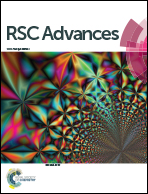Diketopyrrolopyrrole-based acceptors with multi-arms for organic solar cells†
Abstract
Three small molecules SBF-1DPPDCV, SBF-2DPPDCV and SBF-4DPPDCV consisting of a spirobifluorene (SBF) unit as the core and one, two, and four diketopyrrolopyrrole dicyanovinyl (DPPDCV) units as the arms have been designed and synthesized for solution-processed bulk-heterojunction (BHJ) solar cells. The UV-Vis absorption and cyclic voltammetry measurement of these compounds showed that all these compounds have an intense absorption band over 300–750 nm with a LUMO energy level at around −3.87 eV. When pairing with PTB7-Th as the donor, devices fabricated based on PTB7-Th : SBF-4DPPDCV blends showed a decent PCE of 3.85%, which is the highest power conversion efficiency (PCE) amongst the three DPP acceptor fabricated devices without extra treatment. Devices with SBF-1DPPDCV and SBF-2DPPDCV acceptors showed lower PCEs of 0.26% for SBF-1DPPDCV and 0.98% for SBF-2DPPDCV respectively. The three dimensional (3D) structure of SBF-4DPPDCV facilitates the formation of a 3D charge-transport network and thus enables a rational electron-transport ability (1.04 × 10−4 cm2 V−1 s−1), which further leads to a higher Jsc (10.71 mA cm−2). These findings suggest that multi-arm acceptors present better performance than one-arm or two-arm molecules for organic solar cells.



 Please wait while we load your content...
Please wait while we load your content...